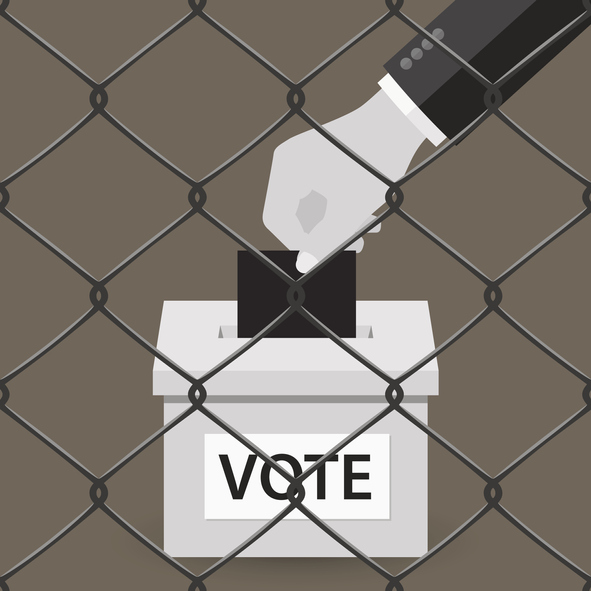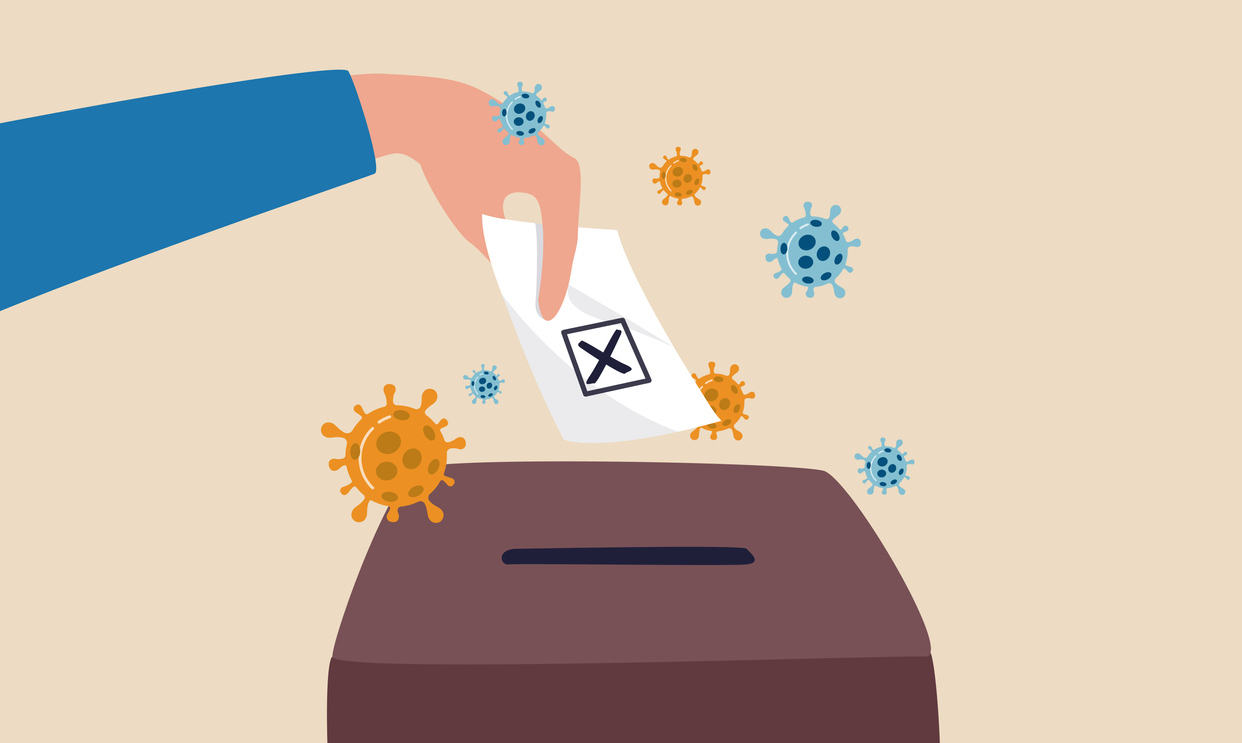
COVID-19 and Nov. 3, 2020: A colossal disaster in the making?
Veteran civil and human rights activist Kerry Lobel spent Election Day texting voters in Georgia. She posted about her experience on Facebook:
“It’s a shit show with long lines, broken or limited numbers of machines, few or no provisional ballots,” she wrote. “Voter suppression or gross incompetence? The result is the same – working voters are waiting 3-4 hours and more to exercise their hard-fought right to vote. White supremacy in action (again).”
Anyone following the news knows the calamities that have come to characterize 2020: a coronavirus pandemic, a Great Depression-like economic collapse, and police violence born of systemic racism.
On top of all this, election observers say Nov. 3, 2020 – Election Day in the U.S. – could result in the largest mass voter disenfranchisement than at any time since the era of poll taxes and literacy tests in the 1960s and before.
Is it voter suppression? Or just incompetence and neglect, made all the worse by COVID-19? Like Kerry Lobel in her Facebook post, Washington Post op-ed columnists Greg Sargent and Paul Waldman suggest it is both:
“Some of it will be because of intentional voter suppression. Some will be because of the lingering effects of the coronavirus pandemic (such as a shortage of poll workers). Some will simply be by accident. If a polling place has three machines and two break down — and poll workers have no idea how to fix them — voting can slow to a crawl. The line stretches longer and longer, and some people decide to simply go home.”
Long lines, broken machines, an absence of poll workers who don’t show up for fear of getting sick – these things will not affect all communities equally, write Sargent and Waldman:
“That can happen without someone making a specific decision to disenfranchise those voters, though you might think of it more as negligence with a predictable result. Especially when we see the same thing in election after election: Voters in wealthier and whiter neighborhoods experiencing few if any problems voting quickly and easily, while those in poorer and more heavily minority neighborhoods being forced to wait for hours.”
Georgia, which held its primary elections on Tuesday, was by no means the first state to experience huge problems.
Troubling signs first surfaced in Wisconsin during the state’s April 7 primary, when Republicans insisted upon in-person voting despite a statewide shelter-in-place order. With so many people afraid to leave their homes, and an acute shortage of poll workers, Milwaukee opened just five polling locations, compared with the 180 it normally operates. The result was chaos.
Making matters worse, 121,000 mail-in ballots were never returned due to a combination of factors – voters never received them, or because of mistakes by election workers or the post office. Most of these “mistakes” happened in Milwaukee and Green Bay, home to a large number of black voters. The outcome serves as an ominous warning for Nov. 3, 2020, when voter turnout in Wisconsin is expected to be double that of April 7.
Mother Jones, in an investigative piece just published in its July-August 2020 edition, tracked the election problems nationwide:
“A number of states that held primaries in early June experienced problems similar to Wisconsin. In Washington, DC, where election officials ill-equipped to handle a surge in absentee ballots and polling places were cut, a larger-than-expected turnout saw in-person voters forced to wait up to six hours. In Maryland, where the governor issued an order to send mail ballots to every registered voter, a million ballots were delayed or never arrived. And in Pennsylvania, the huge volume of mail ballots created counting delays, especially in Philadelphia, that have left some 20 state races uncalled days after the election. Similar delays in November could be seized upon by Trump to attempt to discredit results that would otherwise see him removed from office.”

The magazine reports that the new emphasis on mail-in balloting could lead to trouble-making. “Shady political organizations could send people genuine-seeming but fake absentee ballots, set up bogus websites to trick people into thinking they’ve requested ballots, spread the wrong deadline for returning mail-in ballots, or give incorrect information about the type of documentation or identification needed to vote,” the magazine writes. It should be noted that these scenarios have not taken place in the states that already do widespread voting by mail. Colorado, Hawaii, Oregon, Washington and Utah send all ballots by mail.
Vanita Gupta, President and CEO of the Leadership Conference on Civil and Human Rights, told Mother Jones that the pandemic “could likely be weaponized in the hands of those that already had the intent to suppress the vote. There are a lot more challenges now to conducting elections. There’s a lot more potential for mischief.”
She notes that the “silver lining” of Wisconsin “was that it raised the alarm for folks who weren’t necessarily focusing on the elections and democracy component of COVID-19. It certainly awakened local and state officials – they don’t want those same Wisconsin photos on their watch.”
The list of steps states must take if they want to run clean, efficient elections in November is long – states must expand voter registration to pick up demand created by shuttered DMVs, where people most often register. They must increase capacity for mail-in balloting, and, for those voting in person, they must operate a sufficient number of early voting locations as well as day-of voting locations. They must hire enough poll workers, give them protective equipment, buy new tallying machines for mail-in ballots, and cover increased postage costs (it has been noted that requiring voters to provide postage is a form of a poll tax – voting is supposed to be free).
Congress already has allocated $400 million toward these measures, but Gupta calls this sum “woefully inadequate.” The House-passed HEROES Act, a bill providing more relief from the pandemic’s multiple impacts, includes another $3.6 billion to help state and local election officials manage safe elections with more mail-in voting. But the bill is stalled in the Senate.
Michael Waldman, President of the Brennan Center for Justice, calls House passage of the $3.6 billion a good first step. “Federal funding for safe elections can make sure we avoid a democracy crisis in November,” he said in a statement. “This bill provides the key resources to run safe elections. State and local governments urgently need the money to protect voters and implement needed change.”

COVID-19 and Nov. 3, 2020: a colossal disaster in the making?
But the fact that the funding is tied up in the Senate does not bode well. “Time matters,” Waldman said. “Officials can’t just walk into a Staples in November and pick up the necessary equipment. They face ordering and purchasing deadlines that started [in May]. The Senate must move fast to get funding to state election officials. The vote can’t wait.”
Even before the coronavirus pandemic began, a number of organizations already were hard at work, helping to ensure the integrity of the November elections. These include, just to name a few, the State Infrastructure Fund, Rock the Vote, The Brennan Center for Justice, Fair Elections Center, Campaign Legal Center and the League of Women Voters Education Fund.
There is also much that states and individuals can do. States that are interested in conducting fair elections should already be deep into planning how they will provide sufficient mail-in ballots and safe voting places. In states that are not making adequate plans, it is incumbent upon fair-minded political parties, campaigns and individuals to “flood the zone” — ramp up massive voter education drives so that everyone knows deadlines and rules involving mail-in ballots; carefully monitor polling places so that no one is denied the right to vote; and be ever vigilant regarding unscrupulous efforts to disenfranchise voters through trickery and deception.
What happens if these things don’t happen? Well, come Nov. 3, 2020, we will hear more stories like that of Patricia Wertman, 75 years old and living in an assisted-living facility in D.C., where she is under strict quarantine.
Wertman told the Post she requested a mail-in ballot and received confirmation of her request on May 5. But, like tens of thousands of D.C. residents (including the author of this blog post), the ballot never arrived. When she contacted election officials for guidance, they advised her to vote in person. Her response? “Not possible.”
Wertman’s disenfranchisement was especially upsetting because she has had a near-perfect voting record for more than half a century. “I consider it a moral and civic duty to vote,” she said. “I was/am infuriated by this.”
Individuals, nonprofit groups, local and state officials, Congress, and fair-minded political parties and candidates can work to ensure integrity on Nov. 3, 2020. But every moment we wait, opportunities are lost.
Just ask Patricia Wertman.

